Global Minority Report’ by Durga Nanda Jha of Centre for Policy Analysis, Patna, evaluates the global scenario of the status of minorities as declared by the respective states and also the ground reality in those countries with regard to the status of minorities in those countries. A liner about the conclusion of evaluation is that, “Bharat tops the role of minority protection and giving due respectful living to the minorities of all types, irrespective of their religions, sects and cultural heritages” compared to no less than 118 countries in the world. Other countries with less than 1 million populations are too insignificant to be considered for evaluation. In that sense, the report is truly global in nature. An interesting incident motivated Shri Jha to undertake this stupendous task. “In 2015, when the President of the USA came to Bharat on his second official trip to participate as a State Guest in Bharat’s Republic Day Ceremonies, he delivered a public speech in Siri Fort Auditorium on the last day of his journey. During the speech, he placed emphasis on the fact that Bharat must remain inclusive towards all its religious minorities. He also referred to the provisions of Article 25 of the Constitution of Bharat, ‘that all people are equally entitled to freedom of conscience and the right to freely profess, practice, and propagate religion” (P11). These words of waste wisdom were coming from a person whose near ancestors were deprived of their cultural DNA of African religions after conversion to Christianity and where apartheid prevailed till 1950s when Rev. Martin Luther King took to streets fighting colour bias.
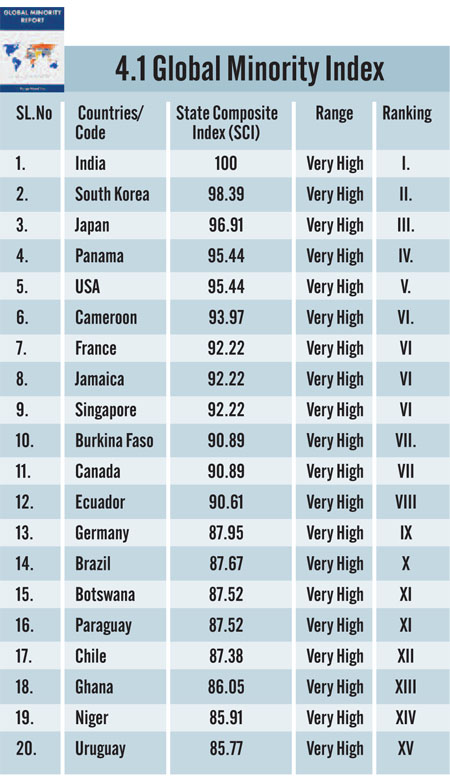
THREE FOLD APPROACH
The report is not just figures and tables, it enables readers to understand why the population has been marked out as minorities in the population fabric of these countries. It helps even a lay reader to understand the roots of minorityism, “Whether it is a minority or a majority religious community, the problem does not lie in the numbers of the community. It lies basically in the problem of non-acceptance” (P 13). It is either way, whether it is majority or by minority. If a minority is refusing to accept the majority, it still poses a problem. Discussion on P14 indicates that when a person converts from Sanatan Dharma to any of the Semitic faiths, it instantly brings about change in his cultural DNA. From an all-inclusive approach to human dignity, he imbibes exclusivity towards all others, except those from his sectarian community within the same religion. This conversion (P 24) brings about ‘Cultural disassociation’, which does not remain strictly a religion related issue; it also has implications for the level of bonding between people and a nation in the persona of new entity. The very next moment of conversion of his ancestral heritage becomes alien to him.
It is an analytical report which can roughly divided into three parts. The first part defines the minorities and minority-ism. It defines the parameters on which their status was decided. In a state or country where minorities are not acceptable, the State and the people try to assimilate them by a) repressive assimilation, by forcing them to convert to majority religion; b) persuasive assimilation, by offering incentives and sops. Other way adopted is by discriminatory treatment, most of the times hard, at times soft. It is only in a promotional State that, neither hard nor soft measures are adopted to assimilate minorities into the mainstream. Instead, their separate identity is nurtured through various promotional measures. This promotional model is followed mainly by Bharat, where minorities enjoy privileges over and above the normal citizen belonging to majority religion (P 24).

The second part deals with variety of global indices pointing to the status of minorities in the respective states. The first category is the ‘State Religion Neutrality Index’; the second category is the ‘State Inclusiveness Index’; the third category is the ‘State Discrimination Index’; and the fourth category is the ‘Global Minority Index’. The ‘State Religion Neutrality Index’ is an assessment of the approach as well as of the relationship of a State towards a religion and its various religionists. The separate indexing of the G20 states in terms of percentages and graphics, are presented in the report. The G20 is one of the most important groups of countries which came into being in 1999. It includes the top twenty economies of the world. Since G20 countries include almost all big countries in terms of economy and population, it is important to know how they treat their religious minorities. Barring China and Saudi Arabia, almost all G20 countries are either fully functional, or reasonably democratic, and roughly two-third of the world’s population lives in these countries. That is why the G20 countries have been picked up from the general list of 110 countries, in order to assess the status of their religious minorities. “Bharat is a special case from the perspective of minority studies because of its accommodative approach to all sects/cults of all religions, including Christianity and Islam. No sects of Christianity and Islam face any problems regarding recognition. Whether they are the Ahmadiya and Baha’i sects of Islam, or Christianity’s Jehova’s Witnesses, everyone can freely pursue their religious practices without fear from the dominant sect of their own religion. No one faces any kind of denial, or problems of recognition of the kind that the Ahmediya and Baha’i sects face in some Islamic countries, as do Jehova’s Witnesses in some Christian dominated countries” (P28).
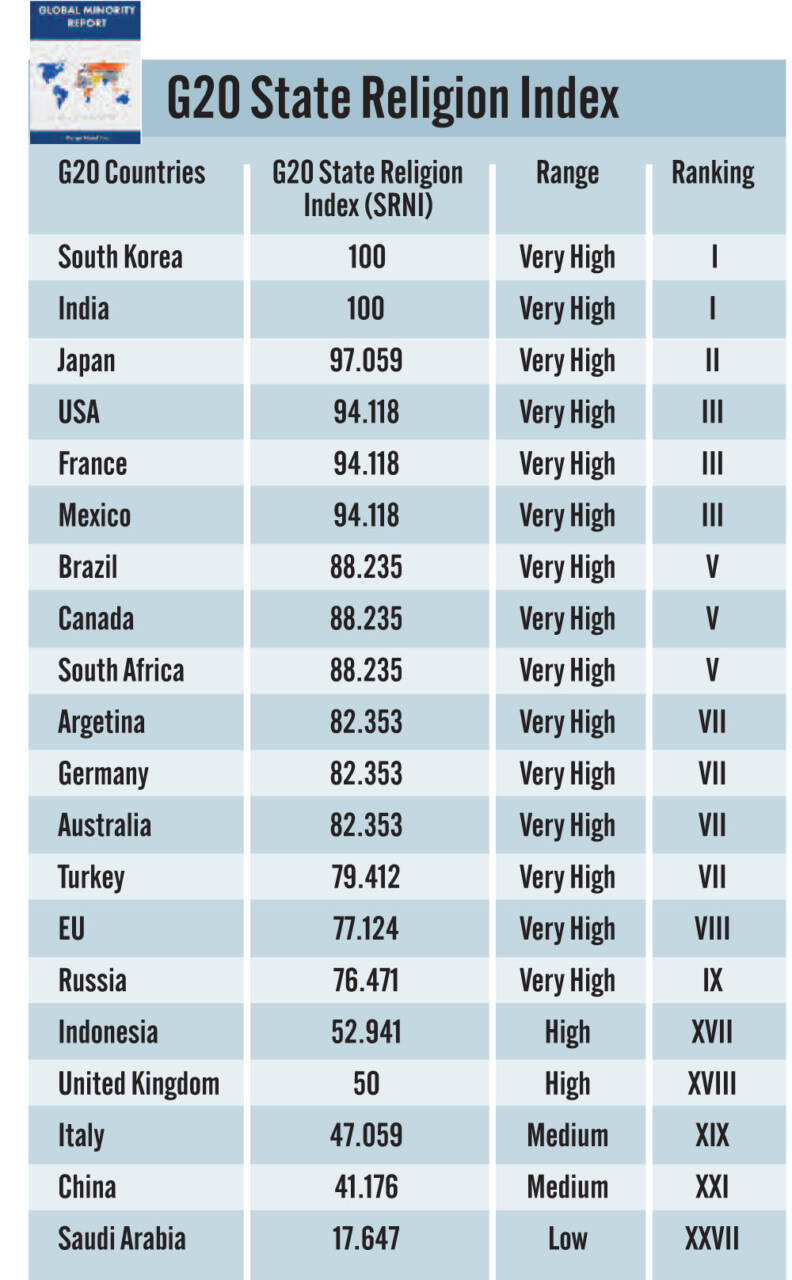
MINORITY RIGHTS IN INDIVIDUAL COUNTRIES
The second part of the report contains status of minorities as defined by the prevailing states constitutions. While reading this section, one comes to know how the respective countries have defined the status of minorities in very sectarian manner. Once again the stark reality of religious discrimination prevailing in the Muslim-dominated countries has come out. “Altogether, there are 48 countries in the world where Muslims are above 50 per cent of the population. Out of 48, in 32 countries, the Muslim population is more than 90 per cent; in 5 countries, the population is more than 80 per cent; in 5 countries, it is more than 70 per cent, and in 6 countries the Muslim population is more than 50 per cent. Out of 48 countries, there are hardly few countries where the democratic tradition is deeply entrenched” (P36).
“Out of 118 countries, 21 Christian dominated countries have a national church. This means that although they have not declared Christianity as their national religion, they are nevertheless officially affiliated to it” (P37).
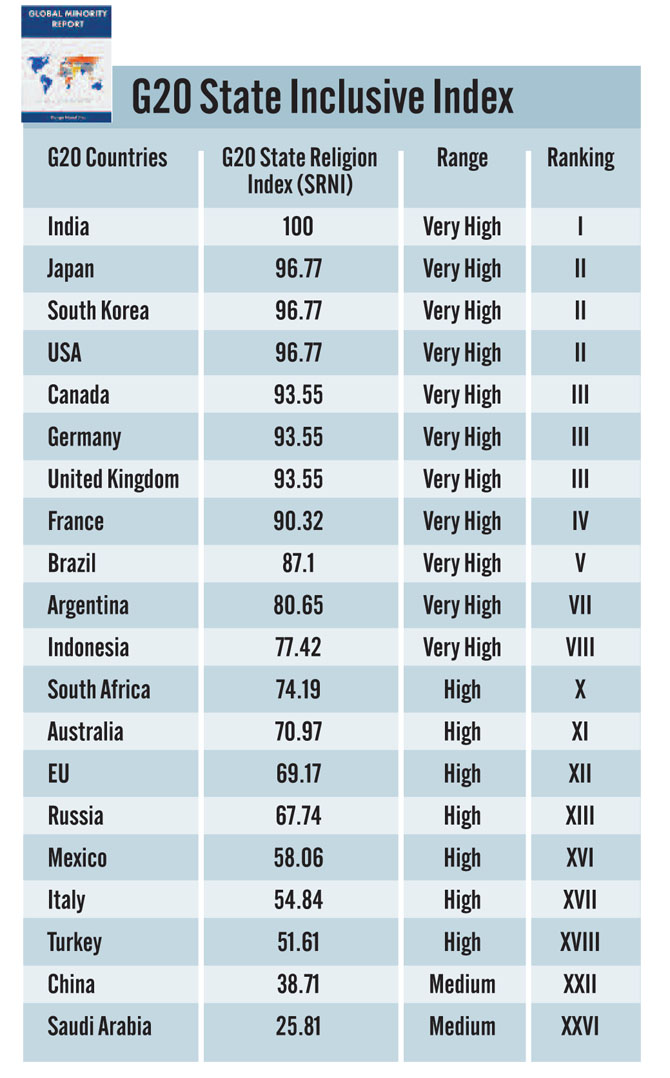
These days, we hear too much about the UN charter on human rights. The report deals in depth with the charter provisions. It takes historical review of the development of the concept. “Issuance of the ‘Magna Carta’ in 1215 is considered as the starting point of this in the context of the modern State. Later, it got strengthened through America’s Bill of Rights, the French Revolution, creation of the League of Nations after World War I, creation of the UNO after World War II, and the UN’s Universal Declaration of Human Rights” (P 44). “On the background of these developments where valuing the human dignity has become a central concern at the global level, the Organisation of Islamic Countries (OIC) came into existence on September 25, 1969. Its headquarters is in Jeddah (Saudi Arabia). It is the second largest organisation of countries after the UN. It has 57 members at present. It claims to work to safeguard interests of the Muslims of the world” (P 45), which is a very sectarian approach. As a result of sumptuous petro-dollar backing, there has been widespread inculcation of Kafirophobia among the Muslim masses. Over the decades, it has led to spread of Wahhabism and religious extremism in many Islamic and non-Islamic countries as well. It went to such an extent that Muslims in Bharat on the pretext of blasphemy, killed innocent people and openly chanted sar tan se juda slogans. It was because
of the backing from the so-called OIC member countries like Qatar.
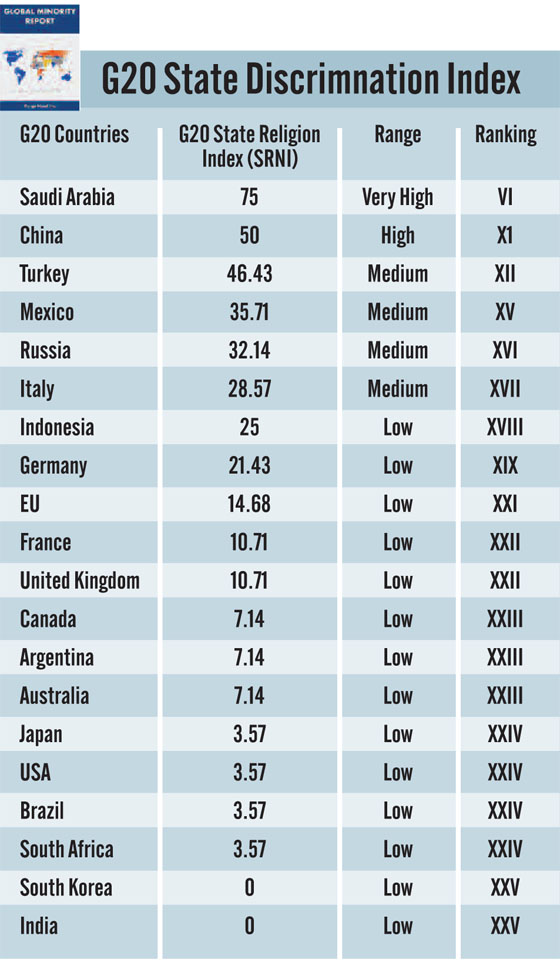
Formation of OIC, in fact, has given setback to the socio-cultural developments in tune with developments in 20th century and is seen to continue in the 21st century. In fact, it led to advent of innumerable terrorists organisations like Talibans, LeT and ISIS. Frank introspection by a leading Pakistan physicist and nuclear scientist Pervez Hoodbhoy in the article, Why are Arabs so powerless?, in The Dawn, May 29, 2021 about mismatch of wealth and retroactive trends in not only in the Arab, but in the Muslim world are worth noting. The Arab countries set up universities on the lines of modern universities in the developed West, however, “They have even imported professors from America and Europe. Yet, the needle has barely flickered so far … The problem is not genetics — Arabs have a brilliant past, and are probably just as smart as Ashkenazi Israelis. But the two groups have different attitudes towards success, and different role models. The Ashkenazi child wants to be Albert Einstein, Niels Bohr, John von Neumann, George Wald, Paul Samuelson, Gertrude Elion, Ralph Lauren, George Soros, or a thousand other such names that fill the textbooks of Physics, Philosophy, Technology, Medicine, and Business. Compare this with the Arab boy who wants to be Salahuddin Ayubi, and the Pakistani lad who dreams of becoming Ertugrul Ghazi on horseback. He does not know about Abdus Salam, our discarded Nobelist” (P55). Pervez Hoodbhoy’s eye opening opinion has remained just a cry in wilderness – aranyarudan even in his own country.
FALLACIES IN THE CONCEPT OF RELIGIOUS FREEDOM
“Regarding religious freedom, it is important that, instead of looking at it in a normative sense, this issue should be analysed in the context of how international lobbyists of religious freedom see it and use it in practical terms. From time to time, internationally expressed concern on the state of religious freedom is mostly not because people are facing obstructions while going to a temple, church, or mosque in a country. It is also not because people are facing other kinds of restrictions in discharging their religious duties” (P 61). For the international champions of religious freedom, it often means ‘unrestricted rights and the opportunity to convert other religionists’. In reality, the term ‘religious freedom’ — which appears innocuous has led unbridled violation of social-cultural-hereditary-democratic freedom of the converts. It has triggered ghetto cultures, extreme exclusiveness and disturbed the rule of law in the respective countries. Kairanas are not just in Bharat, but have proliferated in EU countries. An in-depth assessment of such tendencies triggered by Tablighi Jamat in England was undertaken by Ed Hussain in his very dispassionate approach, “Among the Mosques: A Journey Across Muslim Britain” (2012). The most recent example is Moroccan Muslims in Belgium indulging in rioting after win of Morocco over Belgium in the World Cup.
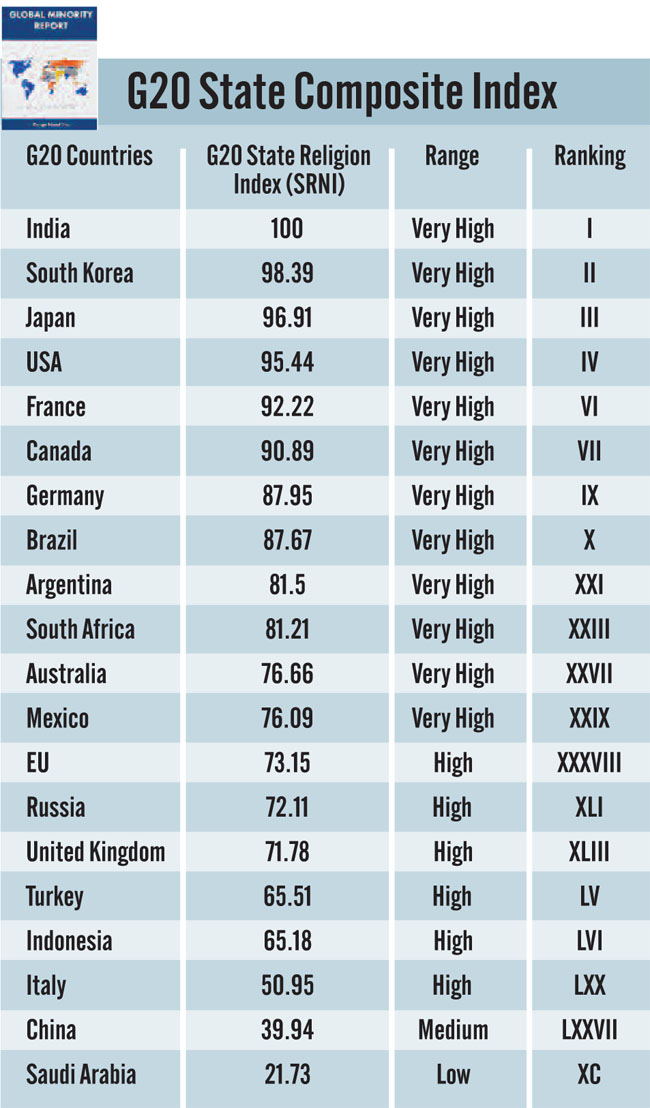
STATISTICS AND EVALUATION
The third part of the report deals with statistical data and evaluation of status of the individual countries on the well-defined index scales. Various tables enlighten readers how constitution of Bharat meets these norms pointing to the articles in the constitution. Bharat tops the positive measure tables on human rights and tolerance index at 100 per cent. The impression one gets is Bharat is too soft a state where the nefarious activities are tolerated to a very large extent, so much that those who indulge in such anti-social activities are sure that the process of law will take undue long time and there are chances to go scot free.
This report makes a very important contribution towards understanding minorities and minorityism globally. It is recommended to be studied in the academic institutions, in departments of sociology and law at the graduation level as a case study.


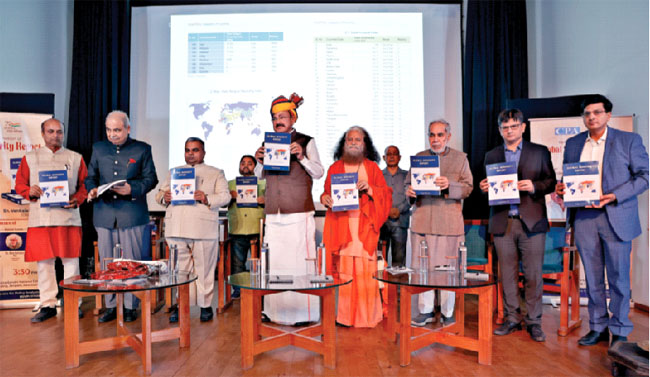



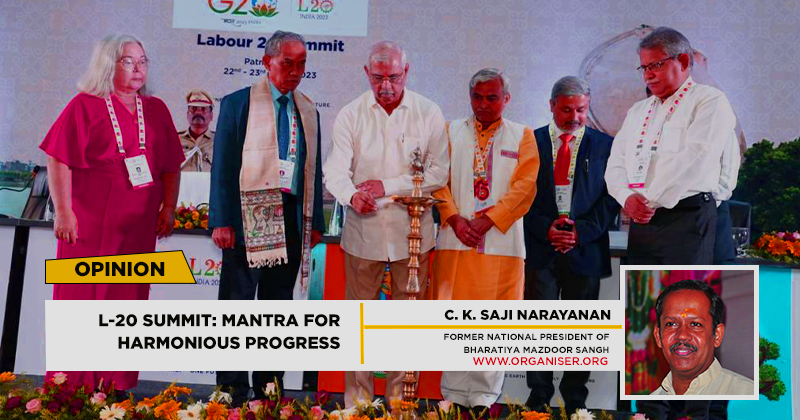




![A Representative image [ANI Photo]](https://organiser.org/wp-content/uploads/2025/12/representative-image-e1765612818961-120x70.webp)







Comments